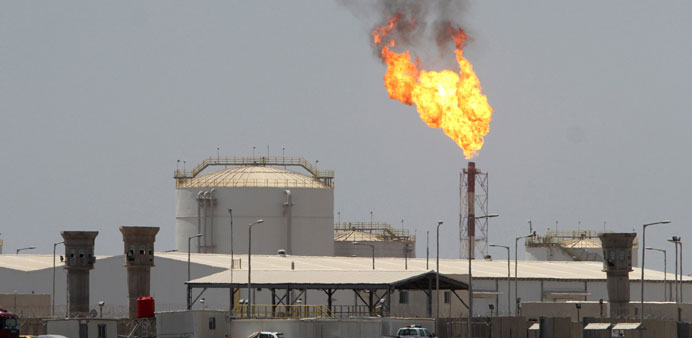Excess gas is burnt off at a pipeline in West Qurna oilfield in Iraq’s southern province of Basra. The Organisation of Petroleum Exporting Countries has pumped above its 30mn-barrel-a-day quota for more than a year, according to data compiled by Bloomberg.
Bloomberg/New York/London
Oil plunged below $40 a barrel in New York for the first time in more than six years on signs the glut of crude will be prolonged.
Prices have tumbled almost 35% since this year’s peak in June as producers maintain output even after an oversupply pushed prices into a bear market. WTI may drop to $32 on the persisting global surplus, Citigroup said in a report August 19. Concerns that China’s economic growth will reduce demand also weighed on futures. Brent also fell to a six- year low.
“It’s clear that the major producers, the Saudis, Russians, the US and others, are battling for market share,” John Kilduff, a partner at Again Capital, a New York-based hedge fund, said by phone.
West Texas Intermediate for October delivery dropped $1.09, or 2.6%, to $40.23 a barrel at 2:07 pm on the New York Mercantile Exchange. It touched $39.86, the lowest level since March 2009. The volume of all futures traded was 20% above the 100-day average. Prices are heading for an eighth weekly loss, the longest streak since 1986.
The US Energy Information Administration said crude supplies rose 2.62mn barrels last week.
A Chinese manufacturing gauge sank to the lowest level since the financial crisis, increasing concern that demand will wane in the world’s second-largest oil consumer.
Brent for October settlement fell $1.38 to $45.24 a barrel on the London-based ICE Futures Europe exchange after reaching $45.07.
Oil balances point to further oversupply throughout 2015, “begging the question how low can oil go?” Citigroup analysts led by Seth Kleinman said in the note.
WTI for delivery in December 2016 traded $6.20 above December 2015. The premium was as high as $7.50 on August 17.
“It could be the result of producers hedging, pressuring the back end of the curve more than front,” said Michael Hiley, head of over-the-counter energy trading at New York-based LPS Partners, a futures brokerage. US crude inventories rose to 456.2mn barrels in the week ended Aug 14, almost 100mn above the five-year average.
The nation’s output climbed 8.8% from a year earlier to 9.52mn barrels a day in July, highest for the month since at least 1920, the industry-funded American Petroleum Institute said on Thursday.
“Eventually, supply and demand will come into balance, but it will take a while,” Chip Hodge, who oversees a $9bn natural-resource bond portfolio as senior managing director at John Hancock in Boston, said by phone.
The Organisation of Petroleum Exporting Countries has pumped above its 30mn-barrel-a-day quota for more than a year, according to data compiled by Bloomberg.
Saudi Arabia told Opec its June production was a record, exceeding the previous high set in 1980. Angola plans to ship 1.83mn barrels a day in October, the most since November 2011, according to a preliminary loading program obtained by Bloomberg.
“The next few weeks would be the right time to start buying into the dips,” Francisco Blanch, Bank of America Corp’s head of commodities research in New York, said in an interview with Bloomberg TV.



